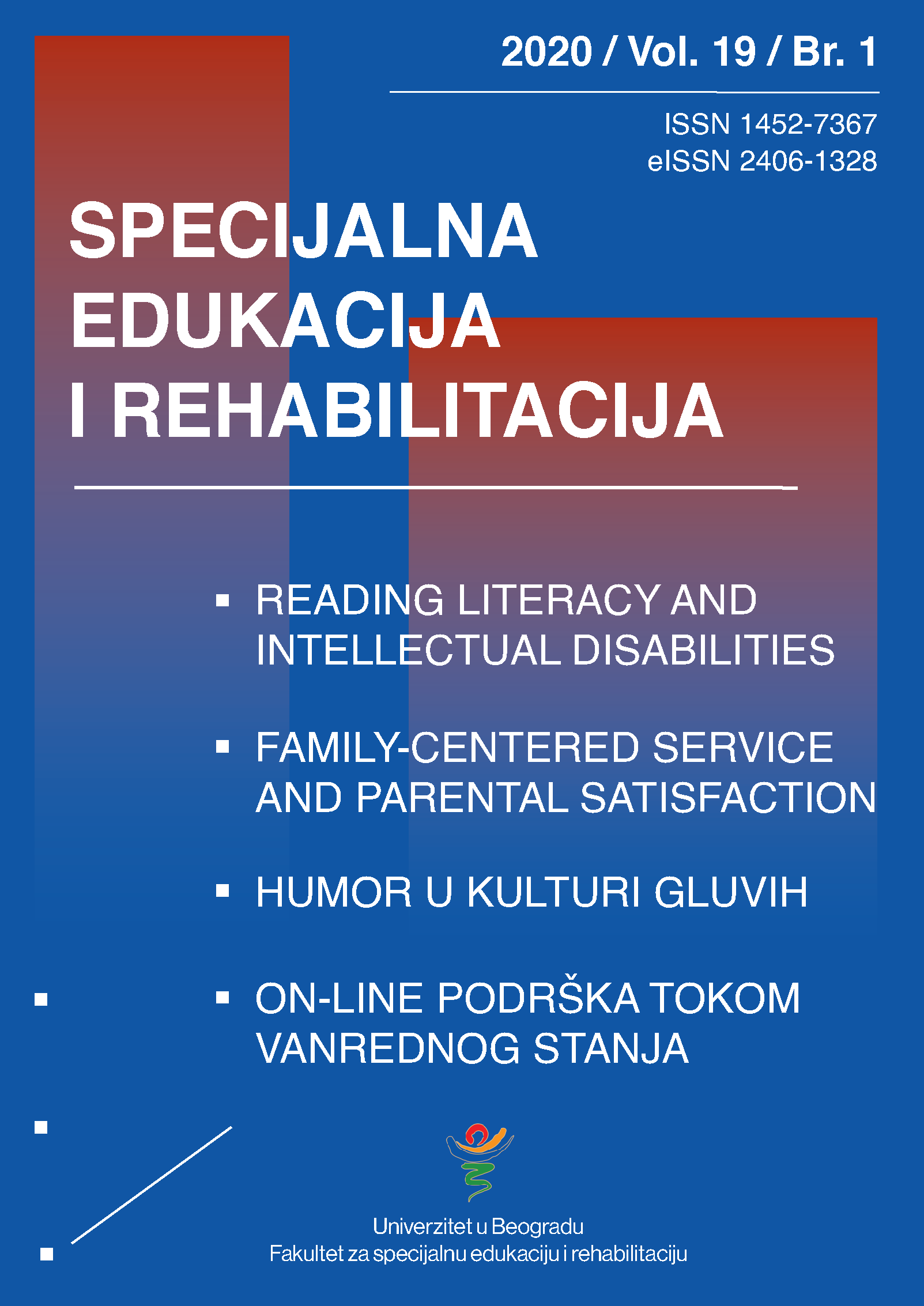Humor u kulturi Gluvih
Sažetak
Vizuelno iskustvo i lingvistička komunikacija bazirana na vizuelnom su dva ključna aspekta kulture Gluvih. Kada se inkorporiraju u humor, njeni članovi dele specifično iskustvo. Rad ima za cilj da pregledom dostupne literature utvrdi da li se humor pripadnika kulture Gluvih razlikuje od humora čujuće populacije i, ako se razlikuje, po čemu i u kojoj meri. Bogatstvo humora kulture Gluvih ogleda se u raznovrsnosti, kreativnosti i složenosti izražavanja putem različitih strategija. Prva strategija odnosi se na pričanje priča na znakovnom jeziku koje na kraju imaju duhovitu, komičnu poentu. Druga strategija se sastoji u imitaciji životinja i ljudi (karikature). Treća strategija ogleda se u stvaranju, putem znakovnog jezika, izmišljenih, maštovitih, apsurdnih slika koje ne postoje u stvarnosti. Četvrta vrsta humora je na znakovnom jeziku koji se teško može prevesti. To je humor koji se mora videti, uživati u njegovoj vizuelnoj logici i redudantnosti slika nemih filmova. Pokušaj da se humor kulture Gluvih prevede i podeli sa čujućom populacijom treba videti ne samo kao interlingvalnu, već i kao interkulturalnu operaciju. Otuda se javlja i nerazumevanje između ove dve socijalne grupe.
Reference
Baby Sign Language.com (2020). Dictionary: Understand. https://www.babysignlanguage.com/dictionary/u/understand/?v=8cee5050eeb7
Baldwin, K. (1982). „The Lumberjack and the Deaf tree”: Image of the deaf in folk narrative. Kentucky Folklore Record, 28(1-2), 6-11.
Bienvenu, M. J. (1994). Reflections of deaf culture in deaf humor. In C. R. Erting, R. C. Johnson, D. L. Smith, & B. D. Snider (Eds.), The Deaf way: Perspectives from the International Conference on Deaf Culture (pp. 16-23). Gallaudet University Press.
Bouchauveau, G. (1994). Deaf humor and culture. In C. R. Erting, R. C. Johnson, D. L. Smith, & B. D. Snider (Eds.), The Deaf way: Perspectives from the International Conference on Deaf Culture (pp. 24-30). Gallaudet University Press.
Carmel, S. J. (1996). Deaf folklore. In J. H. Brunvand (Ed.), American folklore: An encyclopedia. Garland reference library of the humanities (Vol. 1551, pp. 197-200). Garland.
Chiaro, D. (2010). Translation, humour and literature: Translation and humour. Continuum.
Chiaro, D. (2011). Comic takeover or comic makeover?: Notes on humour – translating, translation and (un)translatability. In M. Dynel (Ed.), The pragmatics of humour across discourse domains (pp. 365-378). John Benjamins Publishing Company.
Critchley, S. (2002). On humor. Routledge.
Delaporte, Y. (2002). Les sourds, c’est comme ça. Ethnologie de la surdimutité. Édition de la Maison des Sciences de l’Homme.
Erting, C. J. (1994). Deafness, communication, social identity: Ethnography in a preschool for deaf children. Linstok Press.
Frojd, S. (1976). Dosetka i njen odnos prema nesvesnom. Matica srpska.
Hennies, J. (2003). Gehörlose und gebärdensprache in comics (Teil I). Das Zeichen, 65, 342-353. https://doi.org/10.18355/XL.2016.09.04.108-115
Holmes, J. (2006). Sharing a laugh: Pragmatic aspects of humor and gender in the workplace. Journal of Pragmatics, 38(1), 26-50. https://doi.org/10.1016/j.pragma.2005.06.007
Ivković, S. (2017). Uloga smisla za humor u subjektivnom blagostanju [doktorska disertacija, Univerzitet u Novom Sadu]. NaRDuS. http://nardus.mpn.gov.rs/bitstream/handle/123456789/9826/Disertacija17455.pdf?sequence=1&isAllowed=y
Ladd, P. (2003). Understanding deaf culture: In search of deafhood. Multilingual Matters.
Lefcourt, H. M. (2002). Humor. In S. J. Lopez, & C. R. Snyder (Eds.), Handbook of positive psychology (pp. 619- 631). Oxford University Press.
Martin, R. A. (2003). Sense of humor. In S. J. Lopez, & C. R. Snyder (Eds.), Positive psychological assessment: A handbook of models and measures (pp. 313-326). American Psychological Association.
Martin, D. M., Rich, C. O., & Gayle, B. M. (2004). Humor works: Communication style and humor functions in manager/subordinate relationships. Southern Communication Journal, 69(3), 206-222. https://doi.org/10.1080/10417940409373293
Massie, B. (2006). Participation – have we got an attitude problem? Paper presented in the NDA 5th Annual Conference Civic, Cultural and Social Participation: Building an Inclusive Society, Dublin, Ireland, 16th November.
McDougall, W. (1903). The nature of laughter. Nature, 67, 318-319. https://doi.org/10.1038/067318a0
McDougall, W. (1922). A new theory of laughter. Psyche, 2, 292-303.
Meyer, J. (2000). Humor as a double edged eword: Four functions of humor in communication. Communication Theory, 10(3), 310-331. https://doi.org/10.1111/j.1468-2885.2000.tb00194.x
Paales L. (2004). A hearer’s insight into deaf sign language folklore. Folklore: Electronic Journal of Folklore, (27), 49-84.
Perez, E., & Klimkova, S. (2016). Linguistic and cultural determinacy of Deaf humour. XLinguae Journal, 9(4), 108-115. https://doi.org/10.18355/XL.2016.09.04.108-115
Pol, C. (2014). Deaf humor: A theater performance in Italian sign language [bachelor’s thesis, Università Ca'Foscari Venezia]. Università Ca'Foscari Venezia. DSpace Ca’Foscari Venezia. http://dspace.unive.it/bitstream/handle/10579/5425/845036-1182277.pdf?sequence=2
Radić-Šestić, M., Milanović-Dobrota, B., i Radovanović, V. (2012). Odnos društva prema osobama sa ometenošću. Sociološki pregled, 46(4), 561-582. https://doi.org/10.5937/socpreg1204561R
Radić-Šestić, М. (2013). Teškoće u obrazovanju, zapošljavanju i socijalnoj integraciji nagluvih umetnika. Specijalna edukacija i rehabilitacija, 12(4), 501-521. https://doi.org/10.5937/specedreh12-4499
Radić-Šestić, M., Ostojić, S., i Đoković, S. (2015). Odnos pripadnika kulture gluvih prema kohlearnoj implantaciji. Specijalna edukacija i rehabilitacija, 14(1). 101-124. https://doi.org/10.5937/specedreh1-7156
Ruch, W. (1998). The sense of humor: Explorations of a personality characteristic. Mouton de Gruyter.
Sprecher, S., & Regan, P. C. (2002). Liking some things (in some people) more than others: Partner preferences in romantic relationships and friendships. Journal of Social and Personal Relationships, 19(4), 463- 481. https://doi.org/10.1177/0265407502019004048
Sutton-Spence R., & Napoli D. J. (2012). Deaf jokes and sign language humor. International Journal of Humor Research, 25(3), 311-337. https://doi.org/10.1515/humor-2012-0016
Vandaele, J. (2010). Humour in translation. In Y. Gambier, & L. V. Doorslaer (Eds.), Handbook of Translation Studies (Vol. 1, pp. 147-152). John Benjamins Publishing Company.
Vojtechovsky, R. (2011). Uvod do kultury a sveta Nepocujucich. Myslim – Centrum kultury Nepocujucich.
Wanzer, M., Booth-Butterfield, M., & Booth-Butterfield, S. (2005). „If we didn't use humor, we'd cry”: Humorous coping communication in health care settings. Journal of Health Communication, 10(2), 105-125. https://doi.org/10.1080/10810730590915092
Zanettin, F. (2010). Humour in translated cartoons and comics. In D. Chiaro (Ed.), Translation, humour and the media: Translation and humour. (Vol. 2, pp. 34-52). Continuum.
Sva prava zadržana (c) 2020 Specijalna edukacija i rehabilitacija

Ovaj rad je pod Creative Commons Autorstvo-Deli pod istim uslovima 4.0 međunarodnom licencom.

